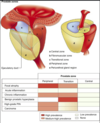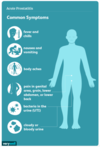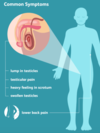10 - Prostate and Genital Tract Flashcards
What are the different ways you should inspect and examine any lump?
Inspect 6 S’s: Site, Size, Shape, Symmetry, Skin changes, Scars
Palpate CAMPFIRE: Tenderness, Temperature, Transillumination, Consistency, Attachments, Mobility, Pulsation, Fluctuation, Irreducibility, Regional lymph nodes, Edge
What investigations should be carried out with a testicular lump?
1st Line: US of scrotum
Blood tests: LDH, b-HCG, AFP

What are some differential diagnoses for scrotal lumps?

ALWAYS CONSIDER MALIGNANCY

Extra-testicular:
- Hydrocele (transilluminates)
- Varicocele
- Epididymal cyst (transilluminates)
- Epididymitis
- Inguinal Hernia
Testicular:
- Tumours
- Torsion
- Benign tumours (Leydig, Sertoli, Lipomas, Fibromas)
- Orchitis
How do hydroceles present and how are they investigated and managed?
Abnormal collection of peritoneal fluid between parietal and visceral layers of tunica vaginalis. Not separate from testes
Symptoms: painless fluctuant swelling that will transilluminate, either unilateral or bilateral. If big can be painful
Causes: primary or secondary (infection, malignancy, trauma), patent processus vaginalis in infants
Ix: Urgent US if aged 20-40 and cannot palpate testes
Mx: if congential often regress spontaneously, ligation if patent processus vaginalis, if large can do surgical management

What is a varicocele and what are the complications of this pathology?
Abnormal dilatation of the pampiniform venous plexus within the spermatic cord. Like a bag of worms and disappears on lying down. Examine patient lying and standing whilst doing valsalva
Often on left due to testicular vein going to left renal vein before IVC
Complications: testicular atrophy and infertility due to increased intra-scrotal temperature so sent for semen analysis

How are varicoceles investigated and managed?
- If asymptomatic and no red flags no investigation and treatment
- If red flags (right sided, doesn’t disappear on lying, acute onset) needs urgent US investigation and then embolisation to ligate spermatic veins either laparoscopically or open

What are epididymal cysts (spermatoceles) and how are they treated?
Benign fluid-filled sacs arising from the epididymis. Smooth fluctuant nodule, above and separate from the testis that will transilluminates, often they are multiple
Very common and not associated with malignancy
No treatment unless large and painful can remove with surgery but avoid in young men as can cause infertility

What is epididymitis, how does it present and how is it managed?
- Unilateral acute onset scrotal pain with associated swelling, overlying erythematous skin, systemic symptoms like fever
- On examination testis is tender and pain relieved on elevation (Prehn’s sign)
- Often due to STI bacteria in young men and enterococcus bacteria in older men
- Antibiotics and analgesia

How can you tell if a lump in the scrotum is an inguinal hernia?
- Cannot get ‘above’ it - cannot get to the superior surface
- Cough will exacerbate and lying down will make it disappear
How do malignant testicular tumours present and how are they managed vaguely?
Painless lumps that are firm, irregular and do not transilluminate. 5% of men have pain so delays diagnosis
Urgent US for diagnosis and then tumour markers
Mx: radical inguinal orchidectomy then chemotherapy
What is orchitis and how is it treated?
- Inflammation of the testis that is often due to mumps virus (history of parotid swelling)
- Rest and analgesia
- If intra-testicular abscess forms then drainage and sometimes orchidectomy

What is the pathophysiology of BPH?
- Most common cause of bladder outlet obstruction and LUTs in men aged over 60
- Prostate converts testosterone to dihydrotestosterone (DHT) using the enzyme 5α-reductase which is more potent. It is the only tissue that always responds to testosterone so DHT remains high and enlarges the prostate
- Occurs in the transitional zone

What are some risk factors for developing BPH?
- Age
- Family history
- Afro-Carribbean ethnicity
- Obesity
What are the presenting features of BPH?
- Voiding and Storage LUTS (e.g terminal dribbling, hesitancy, weak stream)
- Haematuria and haematospermia
- DRE: firm, smooth, symmetrical enlarged prostate. (more than two finger width)

What is the IPSS?
Can be used when men have LUTS to quantify how bad it is
0-7 is mild
8-19 is moderate
20+ is severe

What are some differential diagnoses with BPH?
- Prostate cancer
- UTI
- Bladder cancer

What investigations should you do if you suspect a patient has BPH?

- Urinary frequency and volume chart for all with LUTS
- Urinalysis to rule out infection
- Post-void bladder scan for chronic retention
- PSA
- US to assess prostate and look for any hydronephrosis/retention. Enlarged if prostate>30ml
- Urodynamic studies with BOOI to look for obstruction

How is BPH managed conservatively and medically?
Conservatively
- If asymptomatic found incidentally reassure
- Symptom diary
- Review drugs to see if iatrogenic LUTs, lifestyle advice (e.g cut down caffeine, urethral milking)
Medically
- 1st line: alpha-blockers like Tamsulosin to relax prostate smooth muscle. 4 point improvement in IPSS in few days if works
- 2nd line: if above doesn’t work give 5a-reductase inhibitors like finasteride to decrease prostatic volume by decreasing amount of DHT but can take up to 6 months to take effect
What are some side effects of alpha-blockers used to treat BPH?
- Postural hypotension
- Retrograde ejaculation
- Floppy Iris Syndrome (during cataracts surgery)

BPH is managed surgically if a patient doesn’t respond to medical management or if they are having complications like high pressure retention. How is BPH managed surgically?

1st Line: TURP
Endoscopic removal of obstructive prostate tissue using a diathermy loop to increase the urethral lumen size
Holmium Laser Enucleation of the Prostate (HoLEP)
Holmium:YAG laser used to heat and dissect sections of prostate into the bladder
Others: PVP (Photoselective Vaporization of the Prostate), TUVP (Transurethral Vapourization of the Prostate), and TUMT (Transurethral Microwave Thermotherapy), Prostaectomy

What are some complications of BPH itself and some complications of the surgical treatment for BPH (TURP)?
BPH: high pressure retention with chronic retention so post-renal kidney injury, UTI, haematuria
TURP: haemorrhage, sexual dysfunction, retrograde ejaculation, urethral stricture, TURP syndrome
What is TURP syndrome?
TURP uses hypoosmolar irrigation during the procedure which can result in significant fluid overload and hyponatremia as the fluid enters the circulation through the exposed venous beds
Symptoms: confusion, nausea, agitation, or visual changes due to hyponatraemia and fluid overload

What is the pathophysiology and histology of prostate cancer?
- Most common cancer in men
- Influenced by androgens (testosterone and DHT)
- Mostly acinar adenocarcinomas found in the peripheral zone that are multifocal
Acinar adenocarcinoma: from the glandular cells. Most common form of prostate cancer
Ductal adenocarcinoma: from the cells that line the ducts of the prostate gland. They grow and metastasise faster than acinar

What are the main risk factors for developing prostate cancer?
- Age, Ethnicity, FHx
- BRCA1/2
- Obesity, diabetes mellitus, smoking, little exercise

What are some of the symptoms of prostate cancer and what are some differential diagnoses for this?
- LUTS: weak urinary stream, increased urinary frequency, and urgency
- Advanced localised disease: haematuria, dysuria, incontinence, haematospermia, suprapubic pain, loin pain, rectal tenesmus
- Metastatic: bone pain, lethargy, anorexia, and unexplained weight loss.
- DRE: asymmetry, nodularity, or a fixed irregular mass
DD: BPH, prostatitis, bladder cancer

What are some investigations (not including imaging) if you suspect prostate cancer?
- PSA: however may be artifically raised
- Free:total PSA ratio
- PSA density: which is the serum PSA divided by prostate volume determined by imaging (i.e. TRUS, CT, or MRI)
- Transperineal (Template) biopsy: general anaesthetic and less infection
- TRUS biopsy: local anaesthetic, 12 cores, risk of sepsis

When should men have a repeat prostate biopsy?
- Repeat if negative biopsy but rising PSA or suspicious DRE
- Repeat if atypical small acinar proliferation (ASAP) or >3 sites of high-grade prostatic intraepithelial neoplasia (HGPIN),

How is prostate cancer graded once biopsied?
Low grade: 3+3 = 6
Intermediate: 3+4 = 7
High grade: 7,8,9, 10

What imaging is used to diagnose and stage prostate cancer?
- Multi-parametric MRI can identify abnormal prostate so you can biopsy
- Abdomino-pelvic CT imaging and bone scan

How is prostate cancer managed?
Risk stratification based on PSA levels, Gleason score, and T staging (from TNM).
Low risk: active surveillance, if signs of progression then radical prostatectomy
Intermediate and high risk disease: radical prostatectomy, some intermediate can have surveillance
Metastatic disease: chemotherapy agents and anti-hormonal agents
Castrate–resistant disease: further chemotherapy agents such as Docetaxel. Corticosteroids are used as third line if androgen deprivation therapy and anti-androgen therapy doesn’t work

What are the mainstay treatments of localised or locally advanced prostate cancer?
- Radical prostatectomy: removal of the prostate gland, resection of the seminal vesicles, along with the surrounding tissue +/- dissection of the pelvic lymph nodes
- External-beam radiotherapy: focused radiotherapy just to target prostate gland
- Brachytherapy: transperineal implantation of radioactive seeds

What are some side effects of a radical prostatectomy?
- Erectile dysfunction (affecting 60-90% of men)
- Stress incontinence
- Bladder neck stenosis















































